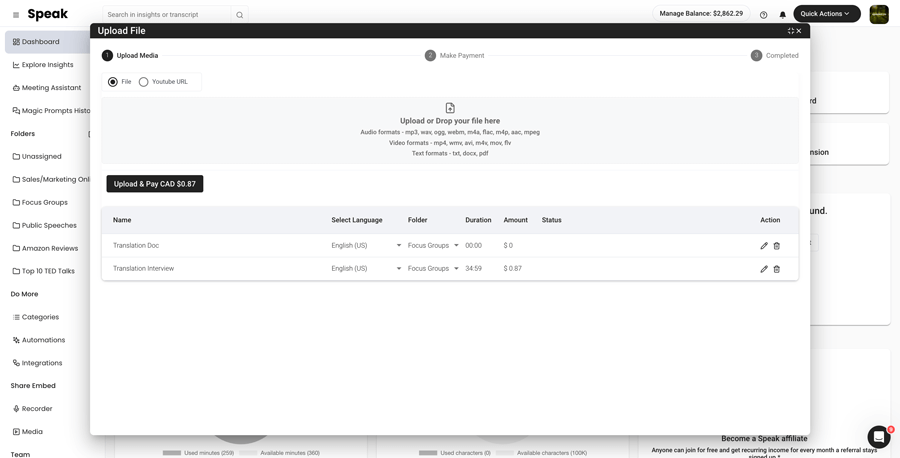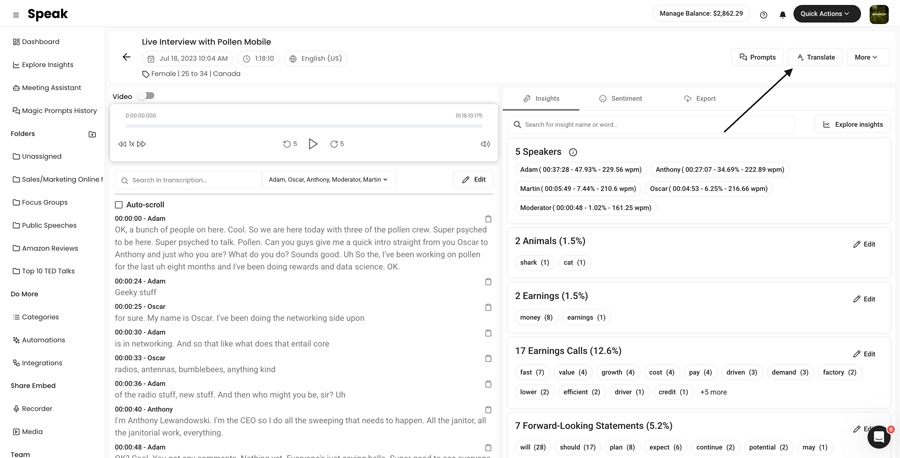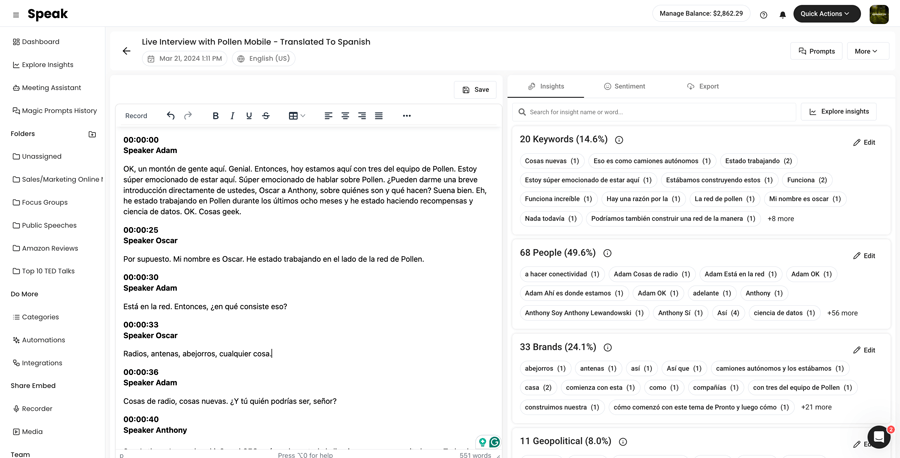How To Translate English (Scottish) to Chinese (Traditional)
Translating English (Scottish) to Chinese (Traditional) is super simple!

Step 1: Register for Speak
Register for Speak using this link.
Once you register, you can instantly begin translating your English (Scottish) to Chinese (Traditional) file(s).

Step 2: Upload Your English (Scottish) file(s)
As soon as you log in, you will be redirected to the dashboard.
Once there, you can select the Quick Action "New Upload".
In Speak, you can seamlessly upload, transcribe and translate audio, video and text files all at once!

Step 3: Translate Your English (Scottish) file(s) to Chinese (Traditional)
Once the file is uploaded, simply visit your file and select "Translate".
If it is an audio and video file, Speak will ask you if you want to keep the speaker names and timestamps in the translation.
Want to translate many files at once? No problem!
You can view the files you want to automatically translate from English (Scottish) to Chinese (Traditional) from the folder level and instantly translate as many files as you need with our artificial intelligence translation in just a few clicks.

Step 4: That's It! View, Analyze, Modify & Export Your New Chinese (Traditional) file(s)
Once the translation is done, you will be alerted and you will see a new document in the same folder your original file is in.
The file will be named the same but with a dash indicating that it is the translated version.
Need support with your English (Scottish) translation?
We are always here and happy to help at Speak!
Just send us a message on live chat on the bottom right corner and we will ensure you are set up for success.
Interested in translating English (Scottish) or other languages to different languages? View our entire list of supported translation languages here.
Automatic, accurate, instant AI translation from English (Scottish) to Chinese (Traditional) is here for you.
Register for Speak using this link and begin translating English (Scottish) to Chinese (Traditional) today.
Unlocking Global Communication: Translate English (Scottish) to Chinese (Traditional) with AI
In today's interconnected world, the ability to communicate across language barriers is more valuable than ever. For businesses, researchers, and individuals looking to bridge the gap between English (Scottish) and Chinese (Traditional), the advancements in automatic translation technology are opening up new horizons. Speak Ai is at the forefront of this technological revolution, offering seamless, accurate, and efficient translation solutions that go beyond mere words, capturing the essence of both languages.
Enhancing Global Connections through Advanced Translation
The need to translate from English (Scottish) to Chinese (Traditional) arises in various contexts, from academic research to business ventures and personal interactions. Understanding the nuances and cultural significance embedded in these languages can significantly enhance communication. Speak Ai, leveraging NLP, large language models, and Generative AI, provides a sophisticated platform that doesn't just translate but ensures that the message's original tone and context are preserved.
The Role of AI in Streamlining Translation Processes
AI-driven translation tools like Speak Ai revolutionize how we approach language barriers. By integrating NLP and sophisticated AI algorithms, Speak Ai offers real-time translation of audio, video, and text with unparalleled accuracy. This capability not only saves valuable time but also drastically reduces the costs associated with traditional translation methods.
Driving Business Growth and Research Innovation
For businesses and researchers, the ability to quickly and accurately translate between English (Scottish) and Chinese (Traditional) facilitates smoother international collaborations, opens up new markets, and accelerates the pace of innovation. Speak Ai's translation tools are designed to meet these specific needs, offering a scalable solution that grows with your project or business.
Locations Where English (Scottish) and Chinese (Traditional) Thrive
English (Scottish), a distinct variation of English spoken in Scotland, and Chinese (Traditional), primarily used in Taiwan, Hong Kong, and Macau, come from vibrant cultures with rich histories. Understanding where these languages are spoken helps in appreciating the full scope of translating between them.
Historical Ties and Cultural Significance
Scotland, known for its historic castles, traditional kilts, and bagpipes, has contributed significantly to literature and science, influencing the global community. On the other hand, regions using Traditional Chinese are known for their historical sites, technological advancements, and economic powerhouses. These areas not only preserve a rich heritage but also play a critical role in the modern global economy.
Fun Facts: Unveiling the Wonders of Scottish English and Traditional Chinese
Exploring the peculiarities of Scottish English and Traditional Chinese reveals fascinating aspects of language and culture that enrich the translation process.
A Glimpse into Linguistic Richness
Scottish English includes words and expressions unique to Scotland, offering a glimpse into its culture and lifestyle. Similarly, Traditional Chinese characters are an art form in themselves, each telling a story and embodying centuries of history.
Comparing English (Scottish) and Chinese (Traditional)
At first glance, Scottish English and Traditional Chinese might seem worlds apart. However, delving deeper into their structures, histories, and usages reveals an intricate web of differences and similarities.
The Essence of Structure and Syntax
While English (Scottish) follows the syntax typical of English languages, it incorporates unique phrases and structures influenced by Gaelic. Traditional Chinese, with its complex characters and tonal nature, offers a different challenge in translation, one that requires not just linguistic but also cultural understanding.
A Fusion of Traditions and Modernity
Both languages beautifully blend tradition with the contemporary, reflecting their cultures’ dynamism. This fusion is an essential consideration for translation, ensuring that modern expressions and traditional contexts are accurately conveyed.
Speak Ai's commitment to breaking down language barriers by translating English (Scottish) to Chinese (Traditional) represents more than just a technological achievement; it's a bridge between cultures, enhancing understanding and cooperation across borders. With over 150K users and a 4.9 rating on G2, Speak Ai is your go-to solution for navigating the nuances of global communication with confidence and ease.
Experience the future of translation – join Speak Ai today!
Frequently Asked Questions
What locations are English (Scottish) and Chinese (Traditional) popular?
English (Scottish) is predominantly spoken in Scotland, part of the United Kingdom, while Chinese (Traditional) is primarily used in Taiwan, Hong Kong, and Macau. Both languages hold significant cultural and historical importance in their respective regions.
What are some fun facts about English (Scottish) and Chinese (Traditional)?
Scottish English is known for its distinct pronunciation and unique words that often puzzle even native English speakers from other regions. Traditional Chinese characters, on the other hand, are among the oldest written characters still in use, with each character being a composite of strokes and radicals.
What are the differences and similarities between English (Scottish) and Chinese (Traditional)?
While fundamentally different in structure, syntax, and use, both languages reflect their cultures' rich histories and traditions. Their evolution showcases a fascinating blend of preserving traditional elements while adapting to the modern world.
Translate English (Scottish) To These Other Supported Languages:
- Translate English (Scottish)-to-Albanian
- Translate English (Scottish)-to-Amharic
- Translate English (Scottish)-to-Arabic (Egypt)
- Translate English (Scottish)-to-Arabic (Iraq)
- Translate English (Scottish)-to-Arabic (Israel)
- Translate English (Scottish)-to-Arabic (Jordan)
- Translate English (Scottish)-to-Arabic (Kuwait)
- Translate English (Scottish)-to-Arabic (Lebanon)
- Translate English (Scottish)-to-Arabic (Oman)
- Translate English (Scottish)-to-Arabic (Palestinian Authority)
- Translate English (Scottish)-to-Arabic (Qatar)
- Translate English (Scottish)-to-Arabic (Saudi Arabia)
- Translate English (Scottish)-to-Arabic (Syrian Arab Republic)
- Translate English (Scottish)-to-Arabic (United Arab Emirates)
- Translate English (Scottish)-to-Arabic Modern Standard (Bahrain)
- Translate English (Scottish)-to-Armenian
- Translate English (Scottish)-to-Azerbaijani
- Translate English (Scottish)-to-Bengali
- Translate English (Scottish)-to-Bosnian
- Translate English (Scottish)-to-Bulgarian
- Translate English (Scottish)-to-Catalan
- Translate English (Scottish)-to-Chinese (Cantonese, Traditional)
- Translate English (Scottish)-to-Chinese (Simplified)
- Translate English (Scottish)-to-Chinese (Traditional)
- Translate English (Scottish)-to-Croatian
- Translate English (Scottish)-to-Czech
- Translate English (Scottish)-to-Danish
- Translate English (Scottish)-to-Dari
- Translate English (Scottish)-to-Dutch
- Translate English (Scottish)-to-English
- Translate English (Scottish)-to-English (Australia)
- Translate English (Scottish)-to-English (India)
- Translate English (Scottish)-to-English (Ireland)
- Translate English (Scottish)-to-English (New Zealand)
- Translate English (Scottish)-to-English (Scottish)
- Translate English (Scottish)-to-English (South African)
- Translate English (Scottish)-to-English (United Kingdom)
- Translate English (Scottish)-to-English (United States)
- Translate English (Scottish)-to-Estonian
- Translate English (Scottish)-to-Farsi (Persian)
- Translate English (Scottish)-to-Finnish
- Translate English (Scottish)-to-French
- Translate English (Scottish)-to-French (Canada)
- Translate English (Scottish)-to-Georgian
- Translate English (Scottish)-to-German
- Translate English (Scottish)-to-German (Swiss)
- Translate English (Scottish)-to-Greek
- Translate English (Scottish)-to-Gujarati
- Translate English (Scottish)-to-Haitian Creole
- Translate English (Scottish)-to-Hausa
- Translate English (Scottish)-to-Hebrew
- Translate English (Scottish)-to-Hindi
- Translate English (Scottish)-to-Hungarian
- Translate English (Scottish)-to-Icelandic
- Translate English (Scottish)-to-Indonesian
- Translate English (Scottish)-to-Irish
- Translate English (Scottish)-to-Italian
- Translate English (Scottish)-to-Japanese
- Translate English (Scottish)-to-Kannada
- Translate English (Scottish)-to-Kazakh
- Translate English (Scottish)-to-Korean
- Translate English (Scottish)-to-Latvian
- Translate English (Scottish)-to-Lithuanian
- Translate English (Scottish)-to-Macedonian
- Translate English (Scottish)-to-Malay
- Translate English (Scottish)-to-Malayalam
- Translate English (Scottish)-to-Maltese
- Translate English (Scottish)-to-Marathi
- Translate English (Scottish)-to-Mongolian
- Translate English (Scottish)-to-Norwegian
- Translate English (Scottish)-to-Pashto
- Translate English (Scottish)-to-Persian
- Translate English (Scottish)-to-Polish
- Translate English (Scottish)-to-Portuguese
- Translate English (Scottish)-to-Portuguese (Brazilian)
- Translate English (Scottish)-to-Portuguese (Portugal)
- Translate English (Scottish)-to-Punjabi
- Translate English (Scottish)-to-Romanian
- Translate English (Scottish)-to-Russian
- Translate English (Scottish)-to-Serbian
- Translate English (Scottish)-to-Sinhala
- Translate English (Scottish)-to-Slovak
- Translate English (Scottish)-to-Slovenian
- Translate English (Scottish)-to-Somali
- Translate English (Scottish)-to-Spanish
- Translate English (Scottish)-to-Spanish (Mexico)
- Translate English (Scottish)-to-Swahili
- Translate English (Scottish)-to-Swedish
- Translate English (Scottish)-to-Tamil
- Translate English (Scottish)-to-Telugu
- Translate English (Scottish)-to-Thai
- Translate English (Scottish)-to-Turkish
- Translate English (Scottish)-to-Ukrainian
- Translate English (Scottish)-to-Urdu
- Translate English (Scottish)-to-Uzbek
- Translate English (Scottish)-to-Vietnamese
- Translate English (Scottish)-to-Welsh



